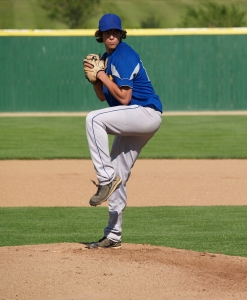Elbow injuries, once seen as a problem primarily affecting professional athletes, are becoming more prevalent among high school and middle school athletes due to increased play and competition at the youth level.
Repetitive stress to a pitcher's ulnar collateral ligament (UCL) - an important stabilizing ligament of the elbow joint - can lead to pain and eventually to the inability to pitch and throw.

Overuse injuries on the rise
A research paper presented at the 2015 annual meeting of the American Orthopaedic Society for Sports Medicine reported that the highest number of Tommy John surgeries is among athletes ages 15- to 19-years-old, with surgeries among those in the age group increasing at a rate of 9.12% per year.
Lead author, Dr. Brandon Erikson of Chicago's Rush University Medical Center, also found that more surgeries are performed in the southern part of the United States (a finding consistent with research showing that warm-weather pitchers are more susceptible to shoulder injuries)
According to a literature review in the May 2014 issue of the Journal of the American Academy of Orthopaedic Surgeons (JAAOS), overuse is the main cause of UCL injury.
The main reasons for such overuse injuries? Year-round sport, with the addition of numerous leagues, travel teams, showcase events and other opportunities for youth to play baseball outside of school, which has contributed to a 10-fold increase of UCL reconstruction in the last decade.
The USA Baseball Medical and Safety Advisory Committee discourages young athletes from participating in multiple teams, especially during the same season, to help prevent overuse injuries.
"Despite all our efforts to educate youth athletes, parents and coaches, the trend of UCL injuries continues to be on the rise," says lead author Jeremy Bruce, MD, an orthopaedic surgeon specializing in sports medicine and a clinical instructor at The University of Tennessee's College of Medicine Chattanooga.
"The success we've had in improving our techniques and outcomes with UCL reconstruction (so-called "Tommy John" surgery) may be adding to our problems in preventing the injuries. The belief that some have about UCL reconstruction being a safe, simple way to improve one's ability to throw is a great misconception that may be adding to our epidemic."
UCL Injury: Prevention is Key
Throwing with fatigue is the main risk factor for overuse injury, whether it is event fatigue (too many pitches in a game), season fatigue (too many pitches in one season) or year-round fatigue (not taking the appropriate 3-4 months off from throwing). In fact, throwing athletes with fatigue are 36 times more likely to suffer shoulder and elbow injuries.
Understanding the risk factors with fatigue and overuse can help prevent UCL injuries:
- Follow recommended guidelines from the American Sports Medicine Institute (ASMI) or STOP Sports Injuries on pitch count, avoid playing on multiple teams, get appropriate rest and follow proper mechanics.
- Proper throwing mechanics are vital as well as the encouragement to play a variety of sports instead of focusing on one sport year-round. The throwing athlete needs at least three months of rest a year, which can occur by playing other non-throwing sports such as soccer.
- Participate in core and shoulder/scapula stabilizer strengthening programs such as "Thrower's Ten" exercises. If the program is guided by a professional, it can help address motion/strength deficits that could become problematic.
- Recognize early symptoms and begin an early therapy program to help prevent unnecessary surgery. If surgery is necessary, ensure all parties (coach, parent and patient) understand there are no short-cuts to get back on the pitching mound earlier. Only time and rehabilitation will prepare the athlete for return to competition.
After the Injury
A trial of nonsurgical measures (e.g., rest followed by rehabilitation) is appropriate, especially for the young athlete with an acute injury or partial UCL tear.
Approximately 10 percent of all major league pitchers have undergone UCL reconstruction and that number is likely to rise. Many of those athletes return to sport because of dedicated therapy and strengthening after the procedure. UCL reconstruction, as with any surgery, is not without risk. While most pitchers are able to return to MLB, and some with a significant improvement in pitching performance, not all athletes return to the same high level of throwing.
According to Dr. Bruce, adolescent athletes in the 14 to 16 year old age group have a lower return to sport after UCL reconstruction surgery than the 18 and over age group, 75 percent versus 85 percent, respectively. It is unknown "whether it is the lack of appropriate post-injury rehabilitation or the loss of interest after having to take a year away from the sport" which contributes to the lower percentage of return. Additionally, UCL reconstruction is an adult surgery and more information on the long-term prognosis after the procedure is needed if offered to the adolescent age group.
Sources:
American Academy of Orthopaedic Surgeons (http://newsroom.aaos.org/media-resources/Press-releases/throwing-injuries-no-longer-just-for-the-pros.htm)
Bruce JR, Andrews JR. Ulnar Collateral Ligament Injuries in the Throwing Athlete. J Am Acad Orthop Surg. 2014;22(5):315-325. doi: 10.5435/JAAOS-22-05-315
"Increases in Tommy John surgeries likely after elbow injury in young athletes." Orthopedics Today (October 2015), citing Erickson BJ, et al. Paper #67. Presented at: American Orthopaedic Society for Sports Medicine; July 7-12, 2015; Orlando, FL (accessed October 20, 2015 at http://www.healio.com/orthopedics/sports-medicine/news/print/orthopedics...)
Kaplan KM, Jobe FW, Morrey BF, Kaufman KR, Hurd WJ. Comparison of Shoulder Range of Motion, Strength, and Playing Time in Uninjured High School Baseball Pitchers Who Reside in Warm- and Cold-Weather Climates. Am. J Sports Med. 2011;39(2): 320-328.
Most recently updated October 20, 2015








